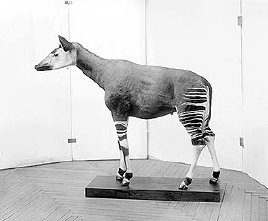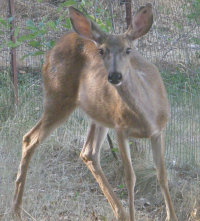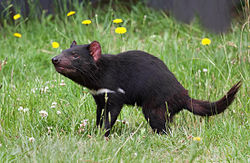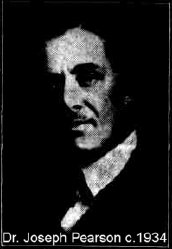

Contact

Home
Tasmania's Miscellaneous Creatures
1916
A STRANGE ANIMAL
Chronicle and North Coast Advertiser (Qld.)
Date: April 18, 1916
Page Number: 3
Mr. H. J. Mather, writing from Currie (King Island) states that while stationed on the Hunter Island in August, 1911, he saw a strange animal, which much resembled the one recently found in Africa, and particulars of
which were given in the Australasian papers. The animal drifted on to the bench during a westerly gale. The body was like that of a deer in size, but the legs were longer; the hoofs were like a deer's. It had a longish neck, after the style of a giraffe, and very big ears— out of all proportion to the size of the animal. The neck inclined upwards. The head was also like a deer's, but the teeth were different— more like a horse's teeth. The tail was long. The height of the body would be about 3ft. 6in., and to the top of the head about 5ft. As to color the neck and body were pale brown the ears dark, and the face white. The fore legs were grey from knee to fetlock; black fetlock, and stripe in front with, white kneecaps, and black and white bands round the forearm and haunches; the hind legs were white from hock to kneecaps, and black and white bands round the forearm and haunches; the hind legs were white from hock to knee. It would seem to be a timid animal, and fleet of foot, although so conspicuous. Was it the "okapi"?
Okapi (Okapia johnstoni), at the National Museum of Victoria in 1917
The Okapi was discovered in 1900 in the Congo. The National Museum received this stuffed adult male on 20 January 1916.
It would
be interesting to know whether Mr. H. J. Mather saw the stuffed okapi while on display which triggered the memory of his okapi sighting
5 years previously as description of the strange animal is very detailed. If that was the case then Mather’s recollection could be
an example of a false memory which involves “confusing or mixing fragments of memory events, some of which may have happened at different
times but which are remembered as occurring together.”

Feral deer

DEVIL CAUGHT IN TRAP
The Mail (Adelaide, SA)
Date: July 29, 1950
Page Number: 10
RESIDENTS of Huonville, an orcharding district south of Hobart, were puzzled recently by a strange animal, which was captured alive and unhurt in a rabbit trap. They took it to the Tasmanian Museum in Hobart, where the museum's biologist, Mr. John DeBavay, recognised it as a genuine Tasmanian devil. The devil, which exists nowhere else in the world, is now almost extinct in Tasmania.
TOP — Mr. DeBavay, wearing gloves to protect his hands from bites, holds the devil.
BOTTOM— A close-up of the nine-month-old female marsupial, which is about the size of a large cat.
1950


Tasmanian Devil
1937
Strange Creature
The Mercury (Hobart, Tas.)
Date: September 29, 1937
Page Number: 4
A creature has appeared on the tessellated pavement, Eaglehawk Neck, the like of which fishermen state they have not seen before, and which they consider is not a seal. The creature is described as 10ft. to 12ft. long, about 5ft. in girth, dark grey to reddish brown in colour, with a small head and a cat-like face. The upper part of the body is covered with short, dark hair, but the lower part is hairless, and the skin smooth and thick with a covering of barnacles. Its weight Is estimated at half a ton to three-quarters of a ton. A peculiar feature is the fins, which are small, and unlike those of seals. The Director of the Tasmanian Museum (Dr. J. Pearson) said yesterday that from the description it appeared that the animal was a seal of some species.








